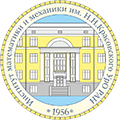ON SEQUENCES OF ELEMENTARY TRANSFORMATIONS IN THE INTEGER PARTITIONS LATTICE
Abstract
An integer partition, or simply, a partition is a nonincreasing sequence \(\lambda = (\lambda_1, \lambda_2, \dots)\) of nonnegative integers that contains only a finite number of nonzero components. The length \(\ell(\lambda)\) of a partition \(\lambda\) is the number of its nonzero components. For convenience, a partition \(\lambda\) will often be written in the form \(\lambda=(\lambda_1, \dots, \lambda_t)\), where \(t\geq\ell(\lambda)\); i.e., we will omit the zeros, starting from some zero component, not forgetting that the sequence is infinite. Let there be natural numbers \(i,j\in\{1,\dots,\ell(\lambda)+1\}\) such that (1) \(\lambda_i-1\geq \lambda_{i+1}\); (2) \(\lambda_{j-1}\geq \lambda_j+1\); (3) \(\lambda_i=\lambda_j+\delta\), where \(\delta\geq2\). We will say that the partition \(\eta={(\lambda_1, \dots, \lambda_i-1, \dots, \lambda_j+1, \dots, \lambda_n)}\) is obtained from a partition \(\lambda=(\lambda_1, \dots, \lambda_i, \dots, \lambda_j, \dots, \lambda_n)\) by an elementary transformation of the first type. Let \(\lambda_i-1\geq \lambda_{i+1}\), where \(i\leq \ell(\lambda)\). A transformation that replaces \(\lambda\) by \(\eta=(\lambda_1, \dots, \lambda_{i-1}, \lambda_i-1, \lambda_{i+1}, \dots)\) will be called an elementary transformation of the second type. The authors showed earlier that a partition \(\mu\) dominates a partition \(\lambda\) if and only if \(\lambda\) can be obtained from \(\mu\) by a finite number (possibly a zero one) of elementary transformations of the pointed types. Let \(\lambda\) and \(\mu\) be two arbitrary partitions such that \(\mu\) dominates \(\lambda\). This work aims to study the shortest sequences of elementary transformations from \(\mu\) to \(\lambda\). As a result, we have built an algorithm that finds all the shortest sequences of this type.
Keywords
Full Text:
PDFReferences
- Andrews G.E. The Theory of Partitions. Cambridge: Cambridge University Press, 1984. 255 p. DOI: 10.1017/CBO9780511608650
- Baransky V.A., Koroleva T.A., Senchonok T.A. On the partition lattice of an integer. Trudy Inst. Mat. i Mekh. UrO RAN, 2015. Vol. 21, No. 3. P. 30–36. (in Russian)
- Baransky V.A., Koroleva T.A., Senchonok T.A. On the partition lattice of all integers. Sib. Electron. Mat. Izv., 2016. Vol. 13. P. 744–753. DOI: 10.17377/semi.2016.13.060 (in Russian)
- Baransky V.A., Senchonok T.A. On the shortest sequences of elementary transformations in the partition lattice. Sib. Electron. Mat. Izv., 2018. Vol. 15. P. 844–852. DOI: 10.17377/semi.2018.15.072 (in Russian)
- Baransky V.A., Senchonok T.A. Bipartite-threshold graphs and lifting rotations of edges in bipartite graphs. Trudy Inst. Mat. i Mekh. UrO RAN, 2023. Vol. 29, No. 1. P. 24–35. DOI: 10.21538/0134-4889-2023-29-1-24-35 (in Russian)
- Baransky V.A., Senchonok T.A. Around the Erdös–Gallai criterion. Ural Math. J., 2023. Vol. 9, No. 1. P. 29–48. DOI: 10.15826/umj.2023.1.003
- Brylawski T. The lattice of integer partitions. Discrete Math., 1973. Vol. 6, No. 3. P. 201–219. DOI: 10.1016/0012-365X(73)90094-0
Article Metrics
Refbacks
- There are currently no refbacks.












